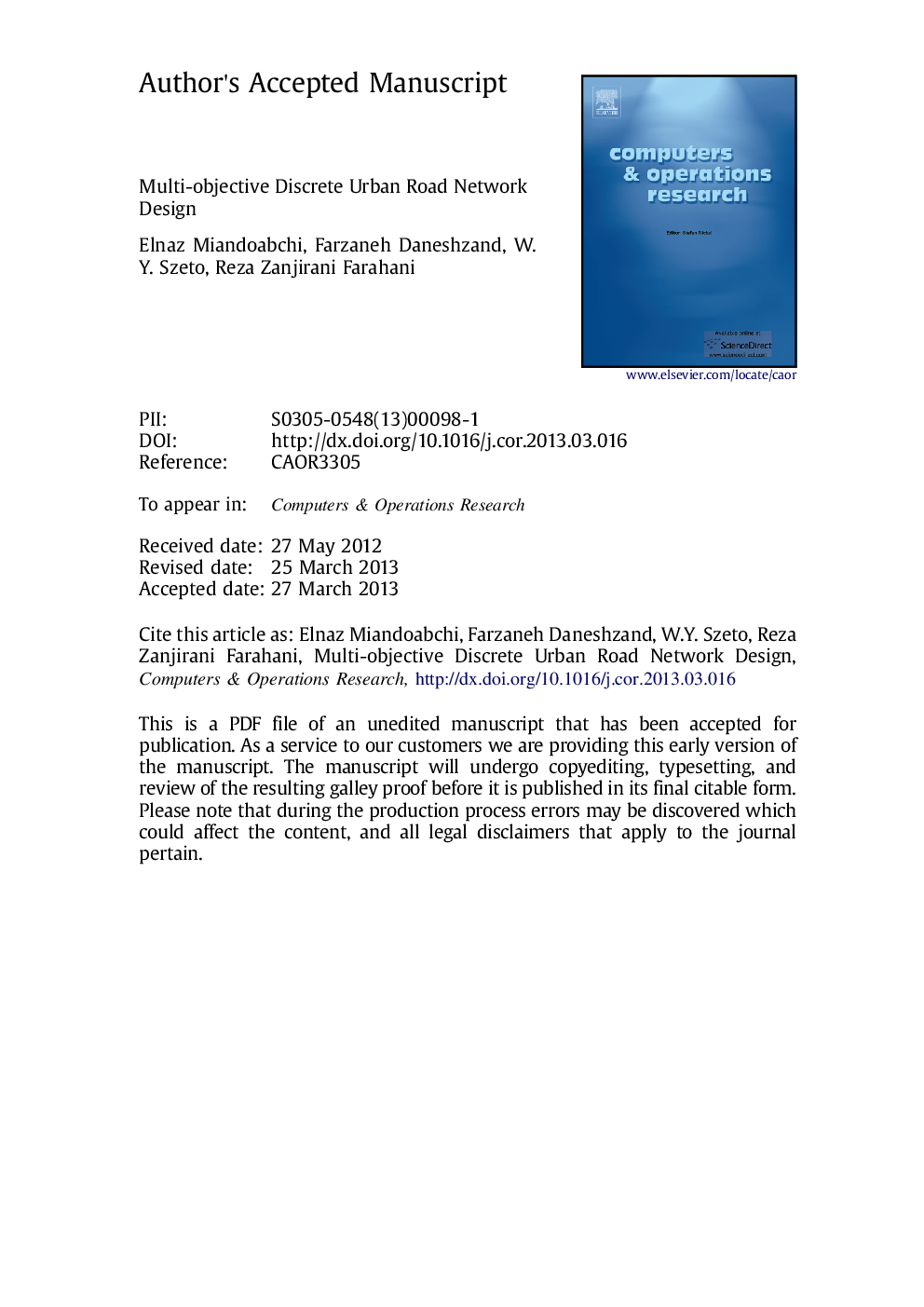| کد مقاله | کد نشریه | سال انتشار | مقاله انگلیسی | نسخه تمام متن |
|---|---|---|---|---|
| 10348028 | 699371 | 2013 | 46 صفحه PDF | دانلود رایگان |
عنوان انگلیسی مقاله ISI
Multi-objective discrete urban road network design
ترجمه فارسی عنوان
طراحی شبکه چند منظوره گسسته شهری
دانلود مقاله + سفارش ترجمه
دانلود مقاله ISI انگلیسی
رایگان برای ایرانیان
کلمات کلیدی
جاده شهری، طراحی شبکه، حمل و نقل، چند هدفه، متآئوریستی هیبرید،
ترجمه چکیده
این مقاله به مسئله طراحی شبکه های جاده ای شهر در چارچوب تصمیم گیری چند منظوره پرداخته است. با توجه به یک شبکه پایه با لینک های دو طرفه و پروژه های ساخت و ساز پیوند و پیوند نامزدی، مشکل این است که ترکیب مطلوب پیوندهای یک طرفه و دو طرفه، انتخاب مطلوب پروژه های گسترش ظرفیت شبکه و تخصیص خطوط بهینه در لینکهای دو طرفه برای بهینه سازی ظرفیت ذخیره شبکه و دو فعالیت جدید مرتبط با زمان سفر. مشکل در دو نوع تغییر وجود دارد: در سناریوی اول، پیوندهای دو طرفه ممکن است تعداد مختلف خطوط را در هر جهت داشته باشند و در سناریوی دوم، لینک های دو طرفه باید دارای تعداد برابر خطوط در هر جهت باشند. تغییرات پیشنهادی به عنوان مشکلات برنامه نویسی عدد صحیح با محدودیت های تعادلی صورت می پذیرد. الگوریتم ژنتیک هیبریدی، یک الگوریتم شبیه سازی تکاملی و یک الگوریتم کلونی زنبور عسل ترکیبی برای حل این دو مسئله جدید پیشنهاد شده است. برای ارزیابی اثربخشی سه الگوریتم، یک معیار جدید نیز پیشنهاد شده است. نتایج محاسباتی برای هر دو مشکل ارائه شده است.
موضوعات مرتبط
مهندسی و علوم پایه
مهندسی کامپیوتر
علوم کامپیوتر (عمومی)
چکیده انگلیسی
This paper addresses the problem of designing urban road networks in a multi-objective decision making framework. Given a base network with only two-way links, and the candidate lane addition and link construction projects, the problem is to find the optimal combination of one-way and two-way links, the optimal selection of network capacity expansion projects, and the optimal lane allocations on two-way links to optimize the reserve capacity of the network, and two new travel time related performance measures. The problem is considered in two variations; in the first scenario, two-way links may have different numbers of lanes in each direction and in the second scenario, two-way links must have equal number of lanes in each direction. The proposed variations are formulated as mixed-integer programming problems with equilibrium constraints. A hybrid genetic algorithm, an evolutionary simulated annealing, and a hybrid artificial bee colony algorithm are proposed to solve these two new problems. A new measure is also proposed to evaluate the effectiveness of the three algorithms. Computational results for both problems are presented.
ناشر
Database: Elsevier - ScienceDirect (ساینس دایرکت)
Journal: Computers & Operations Research - Volume 40, Issue 10, October 2013, Pages 2429-2449
Journal: Computers & Operations Research - Volume 40, Issue 10, October 2013, Pages 2429-2449
نویسندگان
Elnaz Miandoabchi, Farzaneh Daneshzand, W.Y. Szeto, Reza Zanjirani Farahani,
